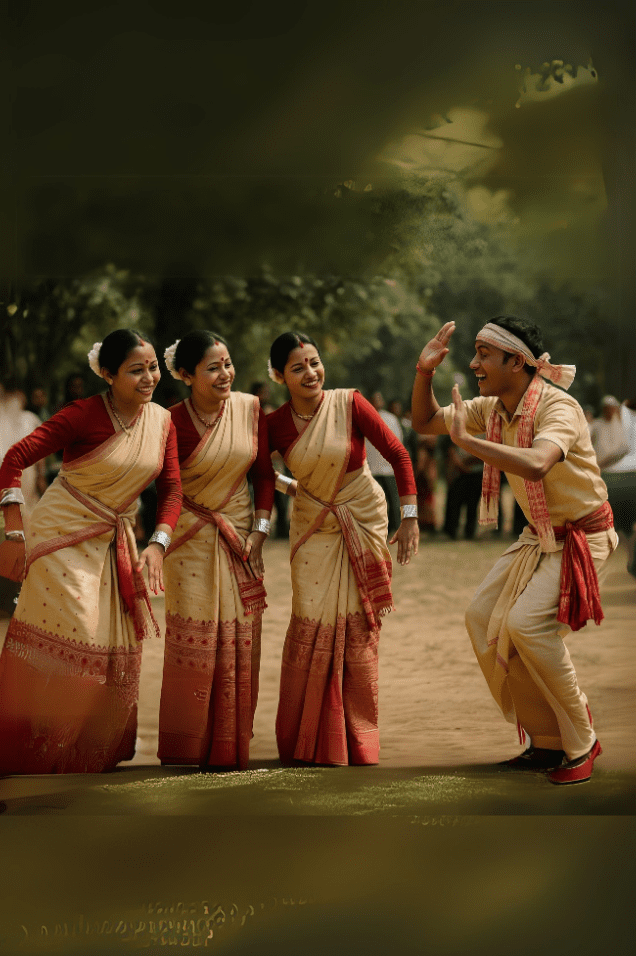
Eastern India, a region known for its diverse culture and rich heritage, is also home to an extraordinary variety of sarees. Each weave tells a unique story, reflecting the region’s history, traditions, and artistic influences. From the resplendent Baluchari sarees of West Bengal to the intricate Ikat weaves of Odisha, the sarees of Eastern India are a testament to the unparalleled craftsmanship and regional influences that define this vibrant part of the country.
Originating from the town of Baluchar in West Bengal, Baluchari sarees are renowned for their elaborate designs and rich motifs. These sarees are typically woven in silk and are distinguished by their intricate pallu, which often features scenes from Indian mythology and epics such as the Ramayana and Mahabharata. The weavers use vibrant colors and intricate detailing to bring these stories to life, creating a narrative that drapes gracefully around the wearer.
The tradition of Baluchari weaving dates back to the 18th century and was initially patronized by the Nawabs of Bengal. Today, the craft is primarily centered in Bishnupur, where skilled artisans continue to preserve and innovate this ancient art form. Each Baluchari saree is a masterpiece, reflecting the cultural heritage and storytelling traditions of West Bengal.
Tant sarees, also known as Bengal cotton sarees, are a staple in the wardrobes of Bengali women. These sarees are celebrated for their lightness, breathability, and elegant designs, making them ideal for the hot and humid climate of the region. Tant sarees are woven from fine cotton threads and feature a variety of motifs, ranging from geometric patterns to floral designs.
The weaving centers for Tant sarees are spread across various towns in West Bengal, such as Shantipur, Phulia, and Dhaniakhali. The sarees often incorporate traditional Bengali motifs like paisleys, lotus flowers, and fish, symbolizing prosperity and cultural identity. Tant sarees are not just garments but expressions of everyday elegance and comfort.
Jamdani sarees, another gem from West Bengal, are famed for their sheer texture and intricate patterns. This ancient weaving technique, which dates back to the Mughal era, involves the painstaking process of hand-weaving fine cotton threads to create delicate, almost ethereal designs. The motifs in Jamdani sarees are usually inspired by nature, featuring flowers, vines, and geometric shapes.
The process of creating a Jamdani saree is labor-intensive, often taking several months to complete a single piece. The artisans, primarily based in the regions of Dhaka (now in Bangladesh) and West Bengal, weave these sarees on traditional handlooms, preserving the age-old techniques passed down through generations. Each Jamdani saree is a testament to the weaver’s skill and dedication, representing a harmonious blend of tradition and artistry.
Moving to Odisha, the Sambalpuri Ikat sarees stand out for their distinctive dyeing technique and vibrant patterns. Ikat involves a resist-dyeing process where the threads are dyed before weaving, creating intricate and symmetrical designs. The weavers of Sambalpur, Bargarh, and Sonepur are renowned for their expertise in this craft, producing sarees that are a riot of colors and patterns.
Sambalpuri sarees often feature traditional motifs such as shankha (conch shell), chakra (wheel), and phula (flower), which hold deep cultural and religious significance in Odisha. The vibrant colors and bold designs of these sarees reflect the region’s rich artistic heritage and the weavers’ mastery of the Ikat technique. Each Sambalpuri saree is a visual symphony, capturing the essence of Odisha’s cultural identity.
Kantha sarees, primarily from West Bengal and parts of Odisha, are known for their distinctive embroidery. The word “Kantha” refers to a running stitch used to create intricate designs and motifs on the saree. Traditionally, Kantha embroidery was used to repurpose old fabrics into quilts, but it has evolved into a celebrated art form for decorating sarees.
Kantha sarees feature a variety of designs, from simple geometric patterns to elaborate depictions of flowers, animals, and folk tales. The embroidery is typically done by rural women, who imbue each piece with their creativity and storytelling. The resulting sarees are a blend of artistry and tradition, reflecting the cultural tapestry of Eastern India.
The sarees of Eastern India are more than just exquisite garments; they are woven stories that capture the essence of the region’s cultural heritage and artistic traditions. Each saree, with its unique weave and design, tells a tale of the region it comes from, reflecting the historical, social, and cultural influences that have shaped it. Whether it’s the mythological narratives of Baluchari, the delicate beauty of Jamdani, the vibrant patterns of Sambalpuri Ikat, or the intricate embroidery of Kantha, these sarees are a celebration of the rich and diverse tapestry that defines Eastern India. Wearing one of these sarees is not just about adorning oneself with a piece of clothing but embracing a piece of history and tradition, carrying forward the stories of generations past.